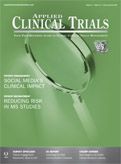Trials, Through the Eyes of Investors
Applied Clinical Trials
Lisa Henderson reports on the J.P. Morgan Healthcare conference and the balance of investment and science.
Here is something that maybe you don’t realize when you are knee-deep in managing a clinical trial, or trying your best to enroll patients, or implementing yet another software system that will “make your job easier.” What you may not realize is that the success or failure of each trial represents a huge part of our economy. Be they stock market activity, investment funds, or venture capital, clinical trials and the “betting” on future successes is serious business.
Maybe I shouldn’t be so naive. Maybe you knew that already. But I spent three days at the 36th Annual J.P. Morgan Global Healthcare
Lisa Henderson

Conference in San Francisco in early January; it was my first time going there, and it was definitely an experience. This is where the CEOs of life sciences companies of all sizes and flavors come to inform investors of their 2017 highlights, 2018 plans, their company financials, and hopefully come across as the next great place in which to invest.
I attended a number of sessions presented by small biotechs and for that I was immensely grateful for my knowledge of and experience reporting on the clinical trials industry. While a lot of the science was beyond me, it was still fascinating to hear the different approaches these companies are taking-mostly toward rare diseases, specifically in cancers. Many of the CEOs presented photos and backgrounds on specific patients, people showing great improvements in the trials, and putting a face and a name to the diseases they are battling.
During the event, on Jan. 8, Axovant announced negative results from a Phase IIB trial for Lewy body dementia. The company ended the program for its investigational compound and its stock dropped 50%. We talk about the costs of clinical trial failures many times, so we can assume the cost of its Phase II trial alone was slightly over $10 million. It was being conducted in 65 sites across the U.S., as well as Western Europe.
On brighter notes, ImmunoGen’s CEO spoke to its candidate mirvetuximab soravtansine in Phase III trials for the treatment of platinum-resistant ovarian cancer. According to ClinicalTrials.gov, NCT02631876 aims to enroll 333 participants in its FORWARD I trial at 106 global sites. A Phase III trial of that size is approximately $20 million to conduct in oncology.
Meanwhile, other life sciences executives added their perspectives to the mix; among them was the recently renamed Syneos Health, representing the INC Research and inVentiv Health combination. According to CEO Alistair Macdonald, the merger brings the strengths of the number three CRO and number one CCO together to bring clinical insights into a sponsor’s commercial strategy. Through positioning of its Integrated Solutions Group, the goal is to bring dedicated resources to the commercial dialogue earlier and continue the relationship well into the next stages of a drug’s development. Macdonald noted that the CRO market is mature, and the CCO less so, and is banking on increasing revenue and penetration on that side of the business.
But as we see, involvement in the earlier stages of a drug may not always pan out. The balance of investment and science is a tricky art.
Lisa Henderson is Editor-in-Chief of Applied Clinical Trials. She can be reached at lisa.henderson@ubm.com. Follow Lisa on Twitter: @trialsonline
